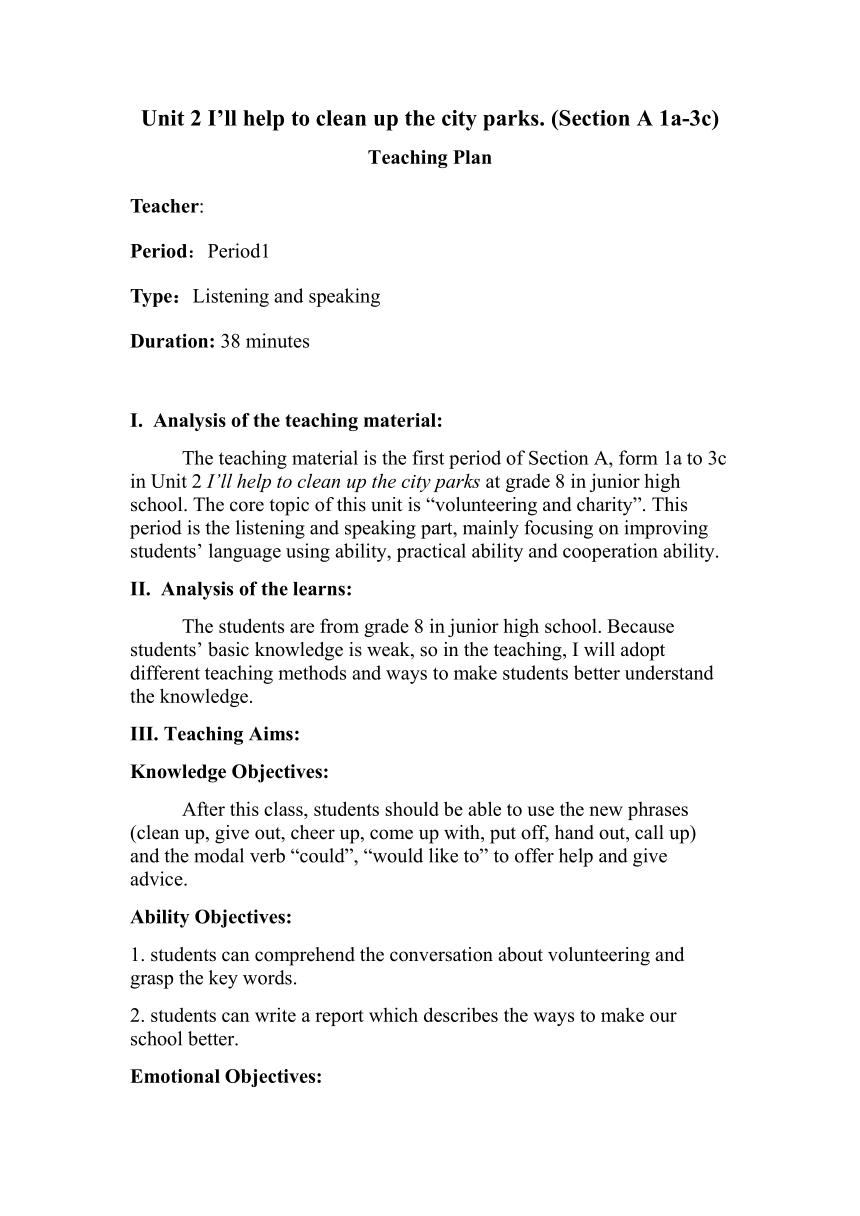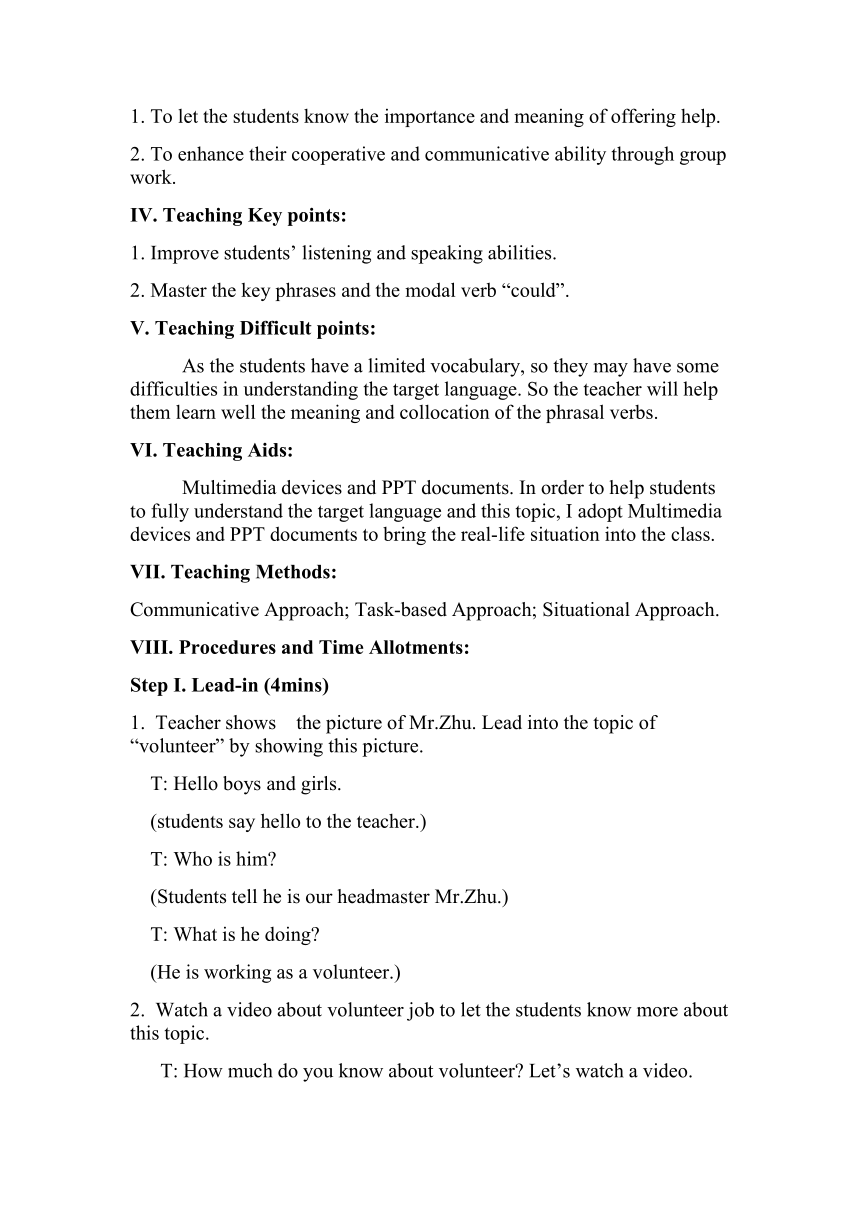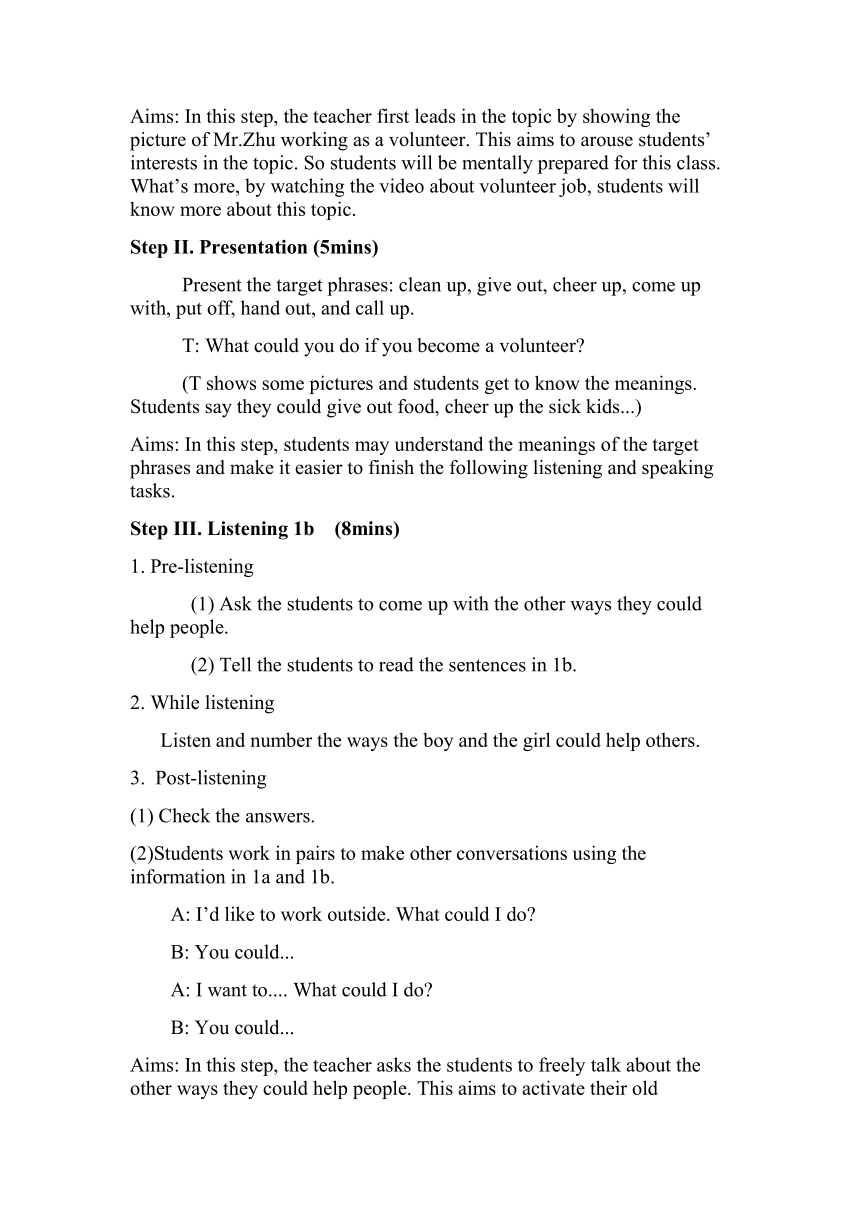Unit 2 I’ll help to clean up the city parksSection A 1a-3c教学设计人教版八年级下册
文档属性
| 名称 | Unit 2 I’ll help to clean up the city parksSection A 1a-3c教学设计人教版八年级下册 |  | |
| 格式 | docx | ||
| 文件大小 | 331.6KB | ||
| 资源类型 | 教案 | ||
| 版本资源 | 人教新目标(Go for it)版 | ||
| 科目 | 英语 | ||
| 更新时间 | 2024-07-24 17:06:33 | ||
图片预览



文档简介
Unit 2 I’ll help to clean up the city parks. (Section A 1a-3c)
Teaching Plan
Teacher:
Period:Period1
Type:Listening and speaking
Duration: 38 minutes
Analysis of the teaching material:
The teaching material is the first period of Section A, form 1a to 3c in Unit 2 I’ll help to clean up the city parks at grade 8 in junior high school. The core topic of this unit is “volunteering and charity”. This period is the listening and speaking part, mainly focusing on improving students’ language using ability, practical ability and cooperation ability.
Analysis of the learns:
The students are from grade 8 in junior high school. Because students’ basic knowledge is weak, so in the teaching, I will adopt different teaching methods and ways to make students better understand the knowledge.
III. Teaching Aims:
Knowledge Objectives:
After this class, students should be able to use the new phrases (clean up, give out, cheer up, come up with, put off, hand out, call up) and the modal verb “could”, “would like to” to offer help and give advice.
Ability Objectives:
1. students can comprehend the conversation about volunteering and grasp the key words.
2. students can write a report which describes the ways to make our school better.
Emotional Objectives:
1. To let the students know the importance and meaning of offering help.
2. To enhance their cooperative and communicative ability through group work.
IV. Teaching Key points:
1. Improve students’ listening and speaking abilities.
2. Master the key phrases and the modal verb “could”.
V. Teaching Difficult points:
As the students have a limited vocabulary, so they may have some difficulties in understanding the target language. So the teacher will help them learn well the meaning and collocation of the phrasal verbs.
VI. Teaching Aids:
Multimedia devices and PPT documents. In order to help students to fully understand the target language and this topic, I adopt Multimedia devices and PPT documents to bring the real-life situation into the class.
VII. Teaching Methods:
Communicative Approach; Task-based Approach; Situational Approach.
VIII. Procedures and Time Allotments:
Step I. Lead-in (4mins)
Teacher shows the picture of Mr.Zhu. Lead into the topic of “volunteer” by showing this picture.
T: Hello boys and girls.
(students say hello to the teacher.)
T: Who is him
(Students tell he is our headmaster Mr.Zhu.)
T: What is he doing
(He is working as a volunteer.)
Watch a video about volunteer job to let the students know more about this topic.
T: How much do you know about volunteer Let’s watch a video.
Aims: In this step, the teacher first leads in the topic by showing the picture of Mr.Zhu working as a volunteer. This aims to arouse students’ interests in the topic. So students will be mentally prepared for this class. What’s more, by watching the video about volunteer job, students will know more about this topic.
Step II. Presentation (5mins)
Present the target phrases: clean up, give out, cheer up, come up with, put off, hand out, and call up.
T: What could you do if you become a volunteer
(T shows some pictures and students get to know the meanings. Students say they could give out food, cheer up the sick kids...)
Aims: In this step, students may understand the meanings of the target phrases and make it easier to finish the following listening and speaking tasks.
Step III. Listening 1b (8mins)
1. Pre-listening
(1) Ask the students to come up with the other ways they could help people.
(2) Tell the students to read the sentences in 1b.
2. While listening
Listen and number the ways the boy and the girl could help others.
Post-listening
(1) Check the answers.
(2)Students work in pairs to make other conversations using the information in 1a and 1b.
A: I’d like to work outside. What could I do
B: You could...
A: I want to.... What could I do
B: You could...
Aims: In this step, the teacher asks the students to freely talk about the other ways they could help people. This aims to activate their old knowledge. Then students read the sentences to get ready for the listening activity. After the listening practice, students will practice the target language by making the conversation.
Step IV. Listening 2b (8mins)
1. Pre-listening
Match the phrases with the pictures.
2. While listening
Listen and finish 2a and 2b.
3. Post-listening
Check the answers in groups and translate the key words.
Aims: In this step, students first know some information of the listening material. The background information will make it easier for the students to finish the listening task.Then students listen to the conversation about some students’ plans for the City Park Clean-Up Day. After listening to this conversation, students translate the key words into Chinese. By doing this, students will learn some key words and phrases and get ready for the next step.
Step V. Group work (10mins)
Someone is calling us. Pick up the phone and then work in groups. Ask students to make a report about how to make our school better.
Ask the students to write down their abilities and stick it on the blackboard.
Students work in groups to have a discussion about how to make our school better.
Give a report.
Aims: In this step, the teacher creates a situation in which our headmaster Mr.Zhu is asking the students to help him come up with some plans to make our school better. Students work in groups to talk about it and then give a report. This report serves to be an output of the listening and an evaluation of their learning.
Step VI. The importance of volunteering (2mins)
Share the old saying “ The rose’s in her hand and the flavor in mine.”
Aims: In this step, students pay attention to the importance of volunteering and can play a part in helping others in the future.
Step VII. Homework (3mins)
1.Review what we have learnt today.
2.Tell your parents what you could volunteer to do to help others.
IX. Blackboard Design:
X. Teaching Reflection:
It is still difficult for the students to freely talk about this topic, so it is suggested to give more examples to make it easier for students to speak, and more practice is needed. And also, the teacher should pay attention to the time.
Teaching Plan
Teacher:
Period:Period1
Type:Listening and speaking
Duration: 38 minutes
Analysis of the teaching material:
The teaching material is the first period of Section A, form 1a to 3c in Unit 2 I’ll help to clean up the city parks at grade 8 in junior high school. The core topic of this unit is “volunteering and charity”. This period is the listening and speaking part, mainly focusing on improving students’ language using ability, practical ability and cooperation ability.
Analysis of the learns:
The students are from grade 8 in junior high school. Because students’ basic knowledge is weak, so in the teaching, I will adopt different teaching methods and ways to make students better understand the knowledge.
III. Teaching Aims:
Knowledge Objectives:
After this class, students should be able to use the new phrases (clean up, give out, cheer up, come up with, put off, hand out, call up) and the modal verb “could”, “would like to” to offer help and give advice.
Ability Objectives:
1. students can comprehend the conversation about volunteering and grasp the key words.
2. students can write a report which describes the ways to make our school better.
Emotional Objectives:
1. To let the students know the importance and meaning of offering help.
2. To enhance their cooperative and communicative ability through group work.
IV. Teaching Key points:
1. Improve students’ listening and speaking abilities.
2. Master the key phrases and the modal verb “could”.
V. Teaching Difficult points:
As the students have a limited vocabulary, so they may have some difficulties in understanding the target language. So the teacher will help them learn well the meaning and collocation of the phrasal verbs.
VI. Teaching Aids:
Multimedia devices and PPT documents. In order to help students to fully understand the target language and this topic, I adopt Multimedia devices and PPT documents to bring the real-life situation into the class.
VII. Teaching Methods:
Communicative Approach; Task-based Approach; Situational Approach.
VIII. Procedures and Time Allotments:
Step I. Lead-in (4mins)
Teacher shows the picture of Mr.Zhu. Lead into the topic of “volunteer” by showing this picture.
T: Hello boys and girls.
(students say hello to the teacher.)
T: Who is him
(Students tell he is our headmaster Mr.Zhu.)
T: What is he doing
(He is working as a volunteer.)
Watch a video about volunteer job to let the students know more about this topic.
T: How much do you know about volunteer Let’s watch a video.
Aims: In this step, the teacher first leads in the topic by showing the picture of Mr.Zhu working as a volunteer. This aims to arouse students’ interests in the topic. So students will be mentally prepared for this class. What’s more, by watching the video about volunteer job, students will know more about this topic.
Step II. Presentation (5mins)
Present the target phrases: clean up, give out, cheer up, come up with, put off, hand out, and call up.
T: What could you do if you become a volunteer
(T shows some pictures and students get to know the meanings. Students say they could give out food, cheer up the sick kids...)
Aims: In this step, students may understand the meanings of the target phrases and make it easier to finish the following listening and speaking tasks.
Step III. Listening 1b (8mins)
1. Pre-listening
(1) Ask the students to come up with the other ways they could help people.
(2) Tell the students to read the sentences in 1b.
2. While listening
Listen and number the ways the boy and the girl could help others.
Post-listening
(1) Check the answers.
(2)Students work in pairs to make other conversations using the information in 1a and 1b.
A: I’d like to work outside. What could I do
B: You could...
A: I want to.... What could I do
B: You could...
Aims: In this step, the teacher asks the students to freely talk about the other ways they could help people. This aims to activate their old knowledge. Then students read the sentences to get ready for the listening activity. After the listening practice, students will practice the target language by making the conversation.
Step IV. Listening 2b (8mins)
1. Pre-listening
Match the phrases with the pictures.
2. While listening
Listen and finish 2a and 2b.
3. Post-listening
Check the answers in groups and translate the key words.
Aims: In this step, students first know some information of the listening material. The background information will make it easier for the students to finish the listening task.Then students listen to the conversation about some students’ plans for the City Park Clean-Up Day. After listening to this conversation, students translate the key words into Chinese. By doing this, students will learn some key words and phrases and get ready for the next step.
Step V. Group work (10mins)
Someone is calling us. Pick up the phone and then work in groups. Ask students to make a report about how to make our school better.
Ask the students to write down their abilities and stick it on the blackboard.
Students work in groups to have a discussion about how to make our school better.
Give a report.
Aims: In this step, the teacher creates a situation in which our headmaster Mr.Zhu is asking the students to help him come up with some plans to make our school better. Students work in groups to talk about it and then give a report. This report serves to be an output of the listening and an evaluation of their learning.
Step VI. The importance of volunteering (2mins)
Share the old saying “ The rose’s in her hand and the flavor in mine.”
Aims: In this step, students pay attention to the importance of volunteering and can play a part in helping others in the future.
Step VII. Homework (3mins)
1.Review what we have learnt today.
2.Tell your parents what you could volunteer to do to help others.
IX. Blackboard Design:
X. Teaching Reflection:
It is still difficult for the students to freely talk about this topic, so it is suggested to give more examples to make it easier for students to speak, and more practice is needed. And also, the teacher should pay attention to the time.
同课章节目录
- Unit 1 What's the matter?
- Section A
- Section B
- Unit 2 I'll help to clean up the city parks.
- Section A
- Section B
- Unit 3 Could you please clean your room?
- Section A
- Section B
- Unit 4 Why don't you talk to your parents?
- Section A
- Section B
- Unit 5 What were you doing when the rainstorm came
- Section A
- Section B
- Review of Units 1-5
- Unit 6 An old man tried to move the mountains.
- Section A
- Section B
- Unit 7 What's the highest mountain in the world?
- Section A
- Section B
- Unit 8 Have you read Treasure Island yet?
- Section A
- Section B
- Unit 9 Have you ever been to a museum?
- Section A
- Section B
- Unit 10 I've had this bike for three years.
- Section A
- Section B
